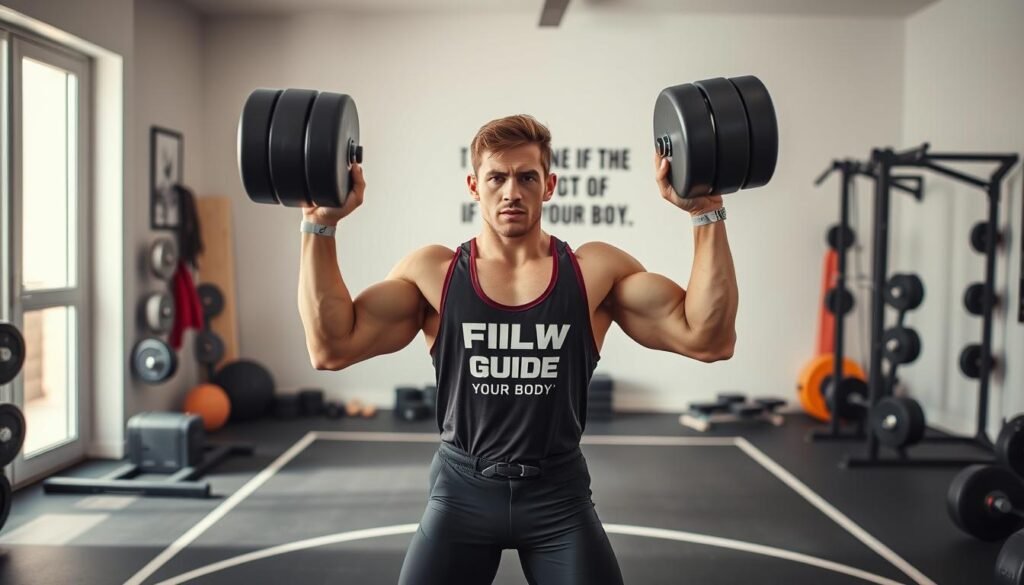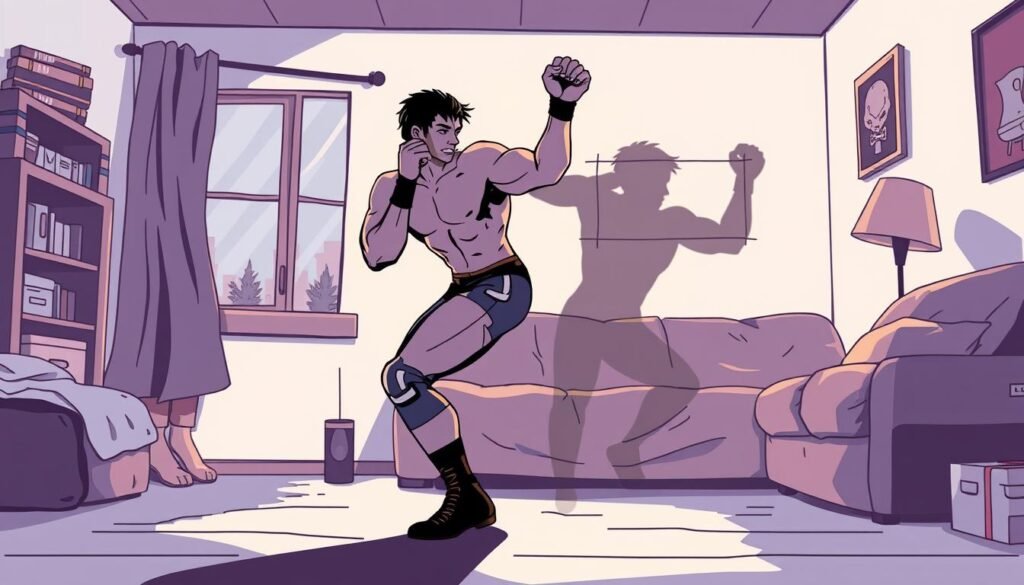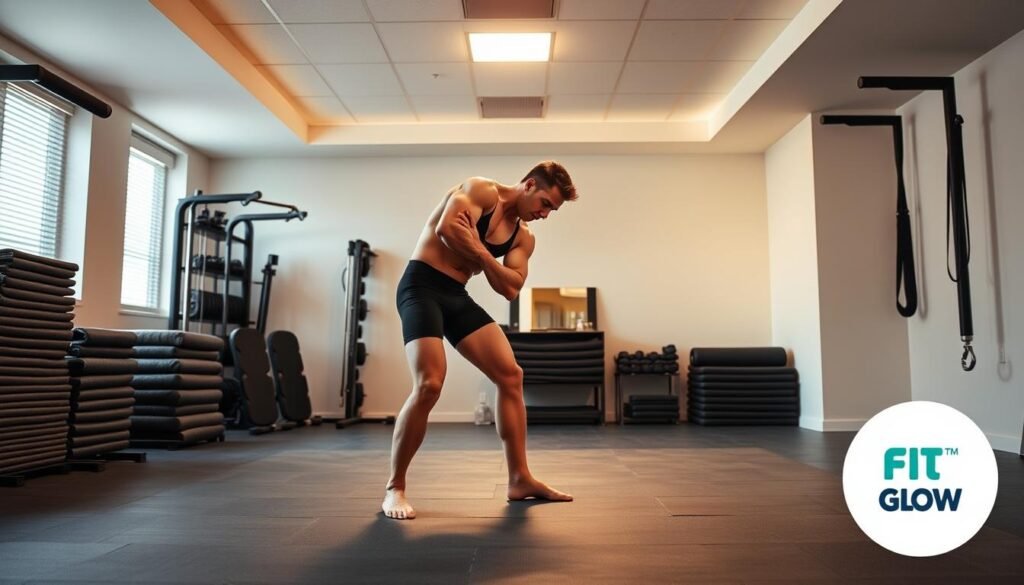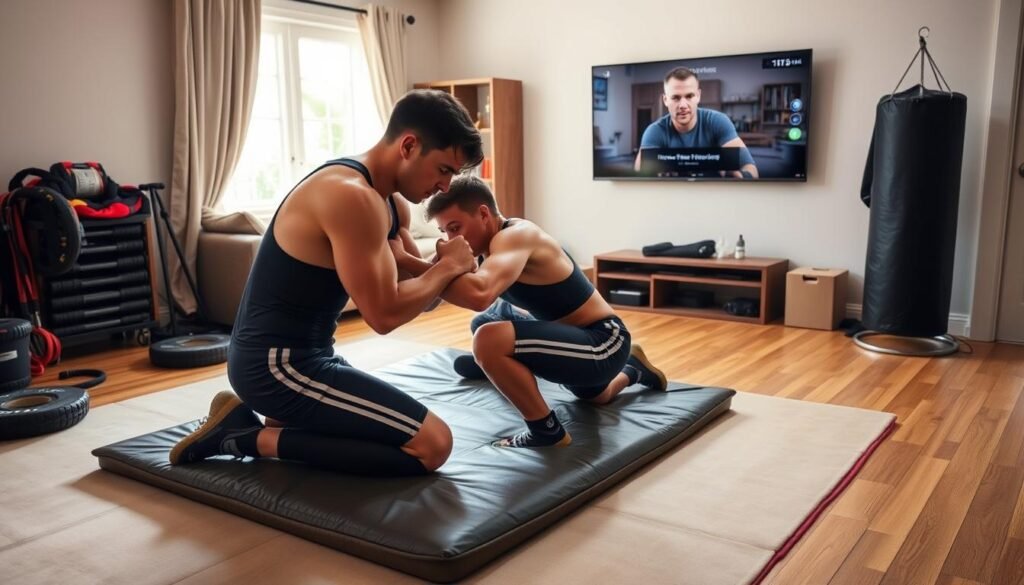Wrestling is one of the oldest sports in the world, demanding a high level of physical and mental toughness. Athletes in this discipline require consistent training to maintain and improve their skills, even when access to traditional facilities is limited.
Embracing the philosophy of “Your Body. Your Glow. Your Guide” from Fit Glow Guide, wrestlers can take control of their development with effective workouts designed for training at home. These workouts focus on building wrestling-specific strength, conditioning, technique, and agility.
By following this comprehensive guide, wrestlers can enhance their abilities from the comfort of their own homes, maximizing results while preventing overtraining and burnout.
Key Takeaways
- Expert tips for maintaining and improving wrestling skills at home.
- Practical workouts that require minimal to no equipment.
- Training methods to enhance wrestling-specific strength and conditioning.
- Techniques to improve agility and technique.
- Strategies for structuring training to prevent overtraining and burnout.
The Benefits of Wrestling Training at Home
For wrestlers, training at home can be a crucial component of their overall development. It allows athletes to maintain and improve their skills even when they’re not at the gym or on the mat.
Maintaining Skills During Off-Season
Home-based wrestling training provides continuity during the off-season, preventing skill regression and maintaining muscle memory for techniques that require consistent practice. This is crucial for maintaining a competitive edge.
| Benefits | Description |
|---|---|
| Skill Maintenance | Prevents skill regression during off-season |
| Supplemental Training | Accelerates progress by increasing overall training volume |
| Wrestling-Specific Fitness | Builds grip strength, core stability, and explosive power |
Supplementing Regular Training
Wrestlers who supplement their regular gym training with home workouts often see accelerated progress. This is because they can increase their overall training volume without overtraining.
Building Wrestling-Specific Fitness

wrestling-specific fitness that directly transfers to match performance. This includes improvements in grip strength, core stability, and explosive power.
By following the Fit Glow Guide approach, wrestlers can customize their home training to their specific needs and level, taking ownership of their development and maintaining their competitive shape year-round.
Essential Wrestling Workouts at Home Without Equipment

Wrestlers can improve their skills without any equipment by incorporating effective home workouts into their training regimen. The Fit Glow Guide philosophy emphasizes developing your body’s natural capabilities through consistent, purposeful practice.
Shadow Wrestling Techniques
Shadow wrestling is an underutilized yet highly effective form of wrestling training. It allows wrestlers to hone their technique while developing specific work capacity and conditioning for wrestling. By visualizing opponents and practicing reactions without a partner, wrestlers can improve their stance and motion.
Stance and Motion Drills
Practicing your wrestling stance and motion is an easy drill to do at home. Find an open space, switch up your lead legs, lower your level, and imagine you’re blocking a shot or facing a wall with your shadow as your opponent. Regular practice helps develop the muscle memory needed to maintain proper positioning even when fatigued during matches.
Bodyweight Strength Exercises
Bodyweight exercises like push-ups, squats, and burpees provide wrestling-specific strength development without requiring any equipment. These exercises can be structured as circuits to build strength, endurance, and technical proficiency simultaneously.
By incorporating these workouts into your training routine, you can enhance your wrestling performance and develop your body’s natural capabilities. Following the Fit Glow Guide, consistent practice creates automatic responses that translate directly to competition performance.
Technical Drills to Perfect Without a Partner
Mastering wrestling techniques requires consistent practice, even without a partner. To improve your skills, focus on specific drills that can be performed at home.
Stand-Up Practice from Bottom Position
Standing up from the bottom position is a crucial skill for wrestlers. Practice stand-ups slowly, focusing on perfect technique rather than speed. This drill helps develop the necessary movements and techniques to escape from the bottom position effectively.

Drop Step and Footwork Training
The drop step is a fundamental footwork technique used in various throws and takedowns. Practice this drill on both sides, focusing on quick feet movement and proper body positioning.
Shot and Defense Visualization
Visualizing shots and defenses against an imaginary opponent helps train the mind to recognize and react to different movements. This mental training is essential for improving reaction time and overall wrestling performance.
| Drill | Focus | Benefits |
|---|---|---|
| Stand-Up Practice | Proper technique, slow execution | Improved bottom position escape |
| Drop Step Training | Quick footwork, balanced positioning | Enhanced throwing and takedown techniques |
| Shot and Defense Visualization | Mental preparation, reaction training | Better reaction time, improved performance |
Building Wrestling-Specific Strength at Home
Developing wrestling-specific strength is crucial for enhancing performance on the mat. This involves focusing on exercises that improve functional movements directly applicable to wrestling.
Core Strengthening Exercises
A strong core is the foundation for almost all wrestling movements and techniques. Core strengthening exercises are essential for wrestlers as they enhance stability, power, and overall performance.
Neck Bridges and Safety
Neck bridges are vital for building neck strength, which is critical for defending against half nelsons and maintaining a good stance. It’s essential to approach neck bridges with caution, starting with wall-assisted variations to prevent injury.
Pull-Up Variations for Grappling Power

Pull-up variations are effective for developing the back, shoulder, and grip strength necessary for improved grappling power and control on the mat. Incorporating these exercises into a home training regimen can significantly enhance a wrestler’s capabilities.
By focusing on these strength exercises, wrestlers can develop the functional muscle needed for enhanced performance, aligning with the Fit Glow Guide philosophy of developing functional muscle that enhances performance.
Conditioning Circuits for Wrestling Endurance

Wrestlers require a unique blend of strength, technique, and endurance, which can be developed through targeted conditioning workouts. Conditioning circuits are an effective way to enhance wrestling performance, allowing athletes to maintain their energy levels throughout matches and tournaments.
Leg Circuit Training
Leg strength and endurance are critical for wrestlers. A renowned example is the Vern Gambetta leg circuit, which includes bodyweight squats, lunges, step-ups, and squat jumps. This circuit builds the specific leg endurance needed to maintain explosiveness throughout competitions.
High-Intensity Interval Training
High-intensity interval training (HIIT) is another effective method for improving wrestling endurance. HIIT involves short bursts of intense exercise followed by brief recovery periods, mimicking the energy demands of actual matches.
Heart Rate Training Zones for Wrestlers
Understanding heart rate training zones is crucial for targeting specific energy systems. By keeping the heart rate between 130-150 BPM, wrestlers can focus on low-intensity aerobic adaptations. For high-intensity anaerobic adaptations, performing near-maximal effort techniques for 20-40 seconds with 1-2 minutes of rest is effective.
These conditioning circuits can be performed at home with no equipment, making them ideal for wrestlers who need to maintain their training regimen without access to a gym. By incorporating these workouts into their routine, wrestlers can improve their performance, reduce the risk of injury, and develop their body’s natural energy systems through progressive, systematic training.
Agility and Footwork Drills to Enhance Performance
Effective wrestling training at home includes a variety of agility and footwork drills designed to boost speed, balance, and overall agility. These exercises are crucial for developing the quick reflexes and rapid movements necessary for success in wrestling.
Jump Rope Variations
Jump rope variations provide an excellent foundation for developing quick feet, rhythm, and conditioning that directly transfers to wrestling movement. Incorporating different jump patterns, such as double unders and high knees, can enhance foot speed and coordination.
Lateral Movement Exercises
Lateral movement exercises improve defensive positioning and the ability to change directions quickly during scrambles and takedown attempts. Using an agility ladder, wrestlers can perform lateral shuffles, carioca drills, and other exercises to enhance their agility.
Plyometric Training for Explosiveness
Plyometric training develops the explosive power needed for successful shots, throws, and escapes in competitive wrestling. Examples include box jumps, depth jumps, and burpees, which can be adapted to different fitness levels.
| Drill Type | Benefits | Example Exercises |
|---|---|---|
| Jump Rope Variations | Improves foot speed, rhythm, and conditioning | Double unders, high knees, alternate foot jumps |
| Lateral Movement Exercises | Enhances defensive positioning and agility | Lateral shuffles, carioca drills, agility ladder drills |
| Plyometric Training | Develops explosive power | Box jumps, depth jumps, burpees |
Conclusion: Maximizing Your Wrestling Development at Home
To maximize your wrestling development, it’s essential to integrate technical drills, strength training, and conditioning exercises into your home workout routine.
By doing so, you’ll be able to maintain and improve your grappling skills even when you’re not on the mat. Consistent home training allows wrestlers to stay on top of their game, and monitoring heart rate during workouts provides valuable feedback on training intensity.
Following the Fit Glow Guide philosophy of “Your Body. Your Glow. Your Guide,” wrestlers should adapt these recommendations to their individual needs. With dedication to these home wrestling workouts, wrestlers of all levels can return to competition stronger and more technically sound.
FAQ
How can I improve my stance motion and overall agility for wrestling?
To enhance your stance motion and agility, incorporate drills like jump rope variations and lateral movement exercises into your training routine. These exercises will help you develop the necessary footwork and quickness to outmaneuver your opponent.
What are some effective conditioning circuits for building wrestling endurance?
Effective conditioning circuits for wrestling endurance include leg circuit training, high-intensity interval training, and heart rate training zones. These exercises will help you build the strength and endurance needed to perform throws and other grappling techniques.
How can I strengthen my core for wrestling?
To strengthen your core, incorporate exercises like planks, Russian twists, and leg raises into your training routine. A strong core will help you maintain a stable position and generate power for takedowns and throws.
What are some ways to improve my explosiveness for wrestling?
To improve your explosiveness, incorporate plyometric training into your routine. Exercises like box jumps and depth jumps will help you develop the necessary power to quickly close the distance to your opponent and execute takedowns.
How can I create a weekly training program for wrestling?
To create a weekly training program, balance technical work and conditioning exercises. Incorporate a mix of stance and motion drills, strength exercises, and conditioning circuits into your routine, and adjust the intensity and volume based on your progressive overload principles.
What are some technical drills I can practice without a partner?
To practice technical drills without a partner, focus on shadow wrestling techniques, stand-up practice from bottom position, and shot and defense visualization. These exercises will help you develop the necessary skills and muscle memory to execute techniques effectively.
















